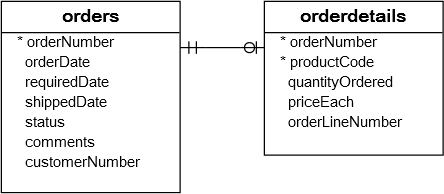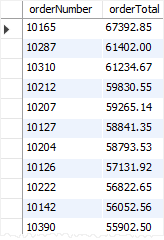Summary: in this tutorial, you will learn how to use the MySQL SUM() function to calculate the sum of values in a set.
Introduction to the MySQL SUM() function
The SUM() function is an aggregate function that allows you to calculate the sum of values in a set. The syntax of the SUM() function is as follows:
SUM(DISTINCT expression)Code language: SQL (Structured Query Language) (sql)Here is how the SUM() function works:
- If you use the
SUM()function in aSELECTstatement that returns no row, theSUM()function returnsNULL, not zero. - The
DISTINCToption directs theSUM()function to calculate the sum of unique values in a set. - The
SUM()function ignores theNULLvalues in the calculation.
MySQL SUM() function illustration
First, create a new table called sum_demo:
CREATE TABLE sum_demo (
n INT
);Code language: SQL (Structured Query Language) (sql)The sum_demo table includes one column called n with the type INT.
Then, insert some rows into the sum_demo table:
INSERT INTO sum_demo(n)
VALUES
(1),
(1),
(2),
(NULL),
(3);Code language: SQL (Structured Query Language) (sql)Third, calculate the total values in the n column using the SUM() function:
SELECT
SUM(n)
FROM
sum_demo;Code language: SQL (Structured Query Language) (sql)
As you can see, the SUM() function calculates the total of 1, 1, 2, and 3. And it ignores NULL.
Finally, calculate the total unique values in the n column using the SUM() function with the DISTINCT option:
SELECT
SUM(DISTINCT n)
FROM
sum_demo;Code language: SQL (Structured Query Language) (sql)
In this case, the SUM() with the DISTINCT option calculates the sum of unique values which are 1, 2, and 3.
MySQL SUM() function examples
We’ll use the table orderdetails from the sample database.
1) Simple MySQL SUM() function example
This example uses the SUM() function to get the total number of items of the order details:
SELECT
SUM(quantityOrdered) SalesQuantity
FROM
orderdetails;Code language: SQL (Structured Query Language) (sql)
2) MySQL SUM() function with expression example
The following shows the order line items of the order number 10110:
SELECT
orderNumber,
quantityOrdered,
priceEach
FROM
orderdetails
WHERE
orderNumber = 10100;Code language: SQL (Structured Query Language) (sql)
To calculate the total for the order number 10110, you use the SUM() function as follows:
SELECT
SUM(quantityOrdered * priceEach) orderTotal
FROM
orderdetails
WHERE
orderNumber = 10100;Code language: SQL (Structured Query Language) (sql)
In this example, the SUM() function calculates the total of the following expression of all order line items of order number 10110:
quantityOrdered * priceEachCode language: SQL (Structured Query Language) (sql)3) MySQL SUM() with the GROUP BY clause example
The SUM() function is often used with the GROUP BY clause to calculate the sum for each group.
For example, you can calculate the total amount of each order by using the SUM() function with the GROUP BY clause as shown in the following query:
SELECT
orderNumber,
SUM(quantityOrdered * priceEach) orderTotal
FROM
orderdetails
GROUP BY
orderNumber
ORDER BY
orderTotal DESC;Code language: SQL (Structured Query Language) (sql)In this example:
- The
GROUP BYclause divides order details into groups grouped by the order number. - The
SUM()function calculates the total of each amount in each order.
4) MySQL SUM() with HAVING clause example
You can use the SUM() function in the HAVING clause to filter the group. This example illustrates how to select orders whose order amounts are greater than 60,000.
SELECT
orderNumber,
SUM(quantityOrdered * priceEach) orderTotal
FROM
orderdetails
GROUP BY
orderNumber
HAVING
SUM(quantityOrdered * priceEach) > 60000
ORDER BY
orderTotal;Code language: SQL (Structured Query Language) (sql)
5) MySQL SUM() with NULL example
The SUM() function returns NULL if the result set is empty. Sometimes, you may want the SUM() function to return zero instead of NULL.
In this case, you can use the COALESCE() function. The COALESCE function accepts two arguments and returns the second argument if the first argument is NULL; otherwise, it returns the first argument.
See the following query:
SELECT
COALESCE(SUM(quantityOrdered * priceEach), 0) result
FROM
orderdetails
WHERE
productCode = 'S1_20';Code language: SQL (Structured Query Language) (sql)
6) MySQL SUM() with join example
See the following orders and orderdetails tables:

You can use the SUM() function in a SELECT with JOIN clause to calculate the sum of values in a table based on a condition specified by the values in another table.
This statement uses the SUM() function to calculate the total amounts of the canceled orders:
SELECT
SUM(quantityOrdered * priceEach) cancelled_amount
FROM
orderdetails
INNER JOIN orders USING (orderNumber)
WHERE
status = 'Cancelled';Code language: SQL (Structured Query Language) (sql)7) MySQL SUM IF example
The following statement uses the SUM() function to calculate the number of items sold for each order status:
SELECT
status,
SUM(quantityOrdered)
FROM
orderdetails
INNER JOIN
orders USING (orderNumber)
GROUP BY status;
Code language: SQL (Structured Query Language) (sql)
If you want to rotate rows to columns, you can use the SUM() function with CASE expression. It is kind of SUMIF logic:
SELECT
SUM(CASE
WHEN status = 'Shipped' THEN quantityOrdered
END) qty_shipped,
SUM(CASE
WHEN status = 'Resolved' THEN quantityOrdered
END) qty_resolved,
SUM(CASE
WHEN status = 'Cancelled' THEN quantityOrdered
END) qty_cancelled,
SUM(CASE
WHEN status = 'On Hold' THEN quantityOrdered
END) qty_on_hold,
SUM(CASE
WHEN status = 'Disputed' THEN quantityOrdered
END) qty_on_disputed,
SUM(CASE
WHEN status = 'In Process' THEN quantityOrdered
END) qty_in_process
FROM
orderdetails
INNER JOIN
orders USING (orderNumber);
Code language: SQL (Structured Query Language) (sql)
Summary
- Use the MySQL
SUM()function to calculate the sum of values in a set.
